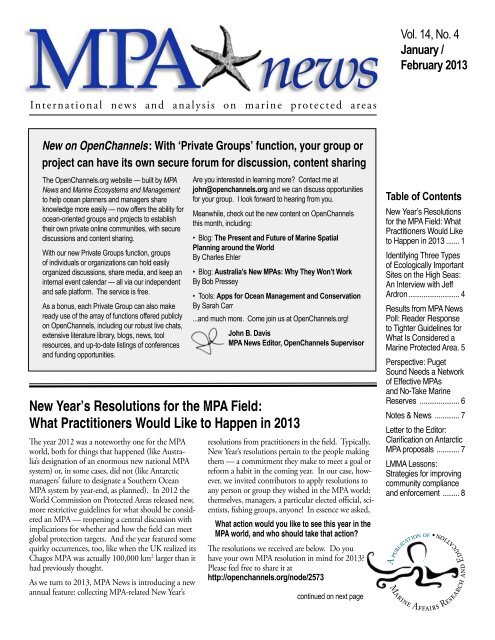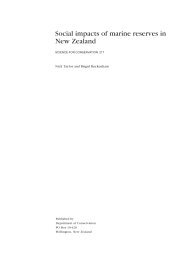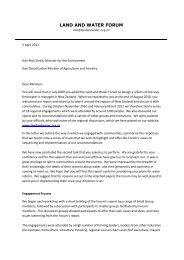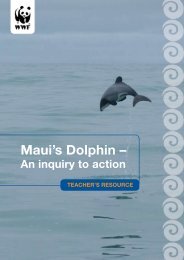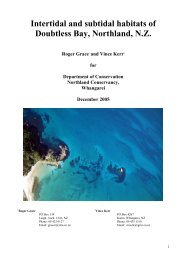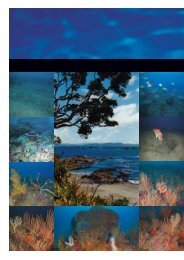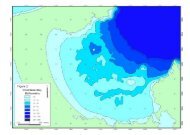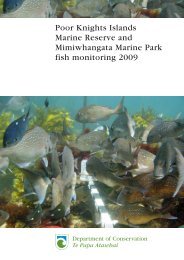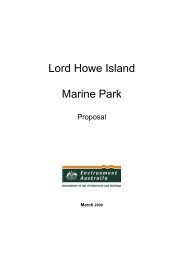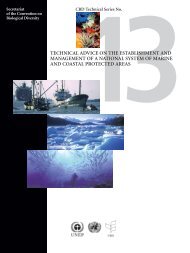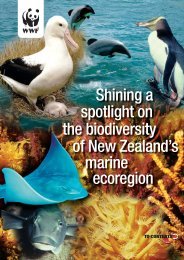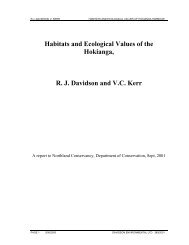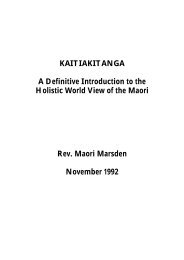MPA News - University of Washington
MPA News - University of Washington
MPA News - University of Washington
You also want an ePaper? Increase the reach of your titles
YUMPU automatically turns print PDFs into web optimized ePapers that Google loves.
heavily used, yet ecologically critical, coastal waters(as in the US states <strong>of</strong> Oregon and California). Thevision is a global movement toward science-basednetworks <strong>of</strong> coastal <strong>MPA</strong>s, designed by stakeholdersand stewarded by local communities invested in theirsuccess. These <strong>MPA</strong>s will be integrated into coastalmanagement and inspire action at all levels <strong>of</strong> governmentto improve water quality, ensure sustainablefisheries and promote sustainable coastal use generally.Fishermen, conservationists, and coastal tourismbasedbusiness will recognize the importance <strong>of</strong> <strong>MPA</strong>sto a healthy ocean and healthy fisheries, and worktogether to ensure the success <strong>of</strong> local protected areas.Yvonne Sadovy de MitchesonDirector, Science and Conservation <strong>of</strong> Reef Fish Aggregations(www.SCRFA.org), <strong>University</strong> <strong>of</strong> Hong KongA resolution for Pacific Island governments and theSecretariat for the Pacific Community: My wish is foruniversal inclusion <strong>of</strong> fish spawning aggregations inmarine protected areas and as an integral part <strong>of</strong> <strong>MPA</strong>planning. Realistically, my resolution for 2013 is thatthis happens across the Pacific. Spawning aggregations<strong>of</strong> many important reef fishes support fisheriesthat feed and generate income for communities andtraders in Pacific Island nations. Yet lack <strong>of</strong> managementand increasing demand for fish are causing theaggregations to disappear along with the tremendousbenefits they bring. Spawning aggregations are alsosome <strong>of</strong> our ocean’s most spectacular natural events.The good news is that many Pacific aggregations arestill in good shape and there is time to protect them.But this requires urgent and strong commitment fromthe region’s government fisheries departments supportedby the Secretariat for the Pacific Community.Kristina GjerdeSenior High Seas Advisor, IUCN Global Marine ProgrammeA resolution for governments and the United Nations:I wish governments in 2013 would support a newagreement for the high seas and deep seabed beyondnational jurisdiction. A new implementing agreementunder the UN Convention on the Law <strong>of</strong> the Sea isneeded to facilitate the establishment <strong>of</strong> a representativesystem <strong>of</strong> marine protected areas for fully 50%<strong>of</strong> the planet, set forth baseline standards for priorimpact assessments while addressing wider issues <strong>of</strong>capacity development, technology transfer, and accessand benefit sharing <strong>of</strong> marine genetic resources.The 1982 UN Convention on the Law <strong>of</strong> the Seais in need <strong>of</strong> updating to reflect more sophisticatedapproaches to protecting the marine environmentbeyond its primary focus on pollution control, whilestill retaining the structure and wide support that theConvention already enjoys.Marie-Aude Sévin and Paul GouinCoordinators, Third International Marine Protected AreasCongress (I<strong>MPA</strong>C 3), National <strong>MPA</strong> Agency, FranceA resolution for the <strong>MPA</strong> field: Do not procrastinate!This applies foremost to ourselves. Here in France,the final rush has begun to get everything ready forI<strong>MPA</strong>C 3, opening in Marseille on 21 October andclosing in Corsica on 27 October. But we hope thatyou, too, can own up to this resolution, because weneed your involvement, and quickly. The Congressis the only <strong>MPA</strong>-specific platform designed to poolglobal expertise and know-how, enabling us hopefullyto meet our common target <strong>of</strong> protecting 10% <strong>of</strong> theEarth’s waters by 2020. So whether you work for an<strong>MPA</strong> authority, an NGO, a research institute or asea-related industry, you are bound to have somethingto learn – and something to contribute. To make sureyou don’t miss out on anything, follow our timeline:• Mid-March: Connect to impac3.org and discoverthe program.• April 30: Remember the submission deadline andmail in your contribution.• June 8: Dress up for World Oceans Day, takephotos, and share them with overseas friends atfacebook.com/impac3 .• June 15: Be an early bird – register for I<strong>MPA</strong>C 3while the coziest hotel rooms are still available.• September: Buy a French (or, alternatively,Corsican) phrasebook.• October 21: Be there!...and one dream for the <strong>MPA</strong> field:Joachim ClaudetEditor, Marine Protected Areas: A Multidisciplinary Approach(Cambridge <strong>University</strong> Press, 2011)I have a dream.I have a dream that one day our perception <strong>of</strong> the oceans willchange.I have a dream that one day marine spatial planning will beaimed at designating areas where uses, and especiallyfisheries, are allowed, rather than prohibited.I have a dream that one day the debate will not be about whatshould or should not be considered an <strong>MPA</strong> but rather aboutthe fishing activities that should or should not be allowed withinthe established marine fished areas.I have a dream that one day the management target will nomore be “percent area to be protected” but rather the amount<strong>of</strong> fishing allowed in a fished area to maintain a healthyecosystem.I have a dream that one day some policy-makers will share thisdream.To comment on any <strong>of</strong>these resolutions:http://openchannels.org/node/2573January - February 20133
Identifying Three Types <strong>of</strong> Ecologically Important Sites on theHigh Seas: An Interview with Jeff ArdronJeff Ardron <strong>of</strong> the Institute for AdvancedSustainability Studies, based in Germany(www.iass-potsdam.de ), spends a lot <strong>of</strong> timethinking about the high seas. He is active in no fewerthan three distinct processes to identify ecologicallyimportant marine sites, specifically in areas beyondnational jurisdiction:• Identifying vulnerable marine ecosystems(VMEs) for regional fisheries management organizationsin the context <strong>of</strong> bottom fisheries;• Identifying ecologically and biologicallysignificant areas (EBSAs) in the context <strong>of</strong> theUN Convention on Biological Diversity; and• Identifying sites that could be <strong>of</strong> outstandinguniversal value (OUV) according to the naturalcriteria <strong>of</strong> the UNESCO World Heritage Convention.(Note: The Convention as currently writtendoes not address sites in areas beyond nationaljurisdiction.)Because each <strong>of</strong> these designations derives from aseparate international institution with its own uniquegoals, each process also involves its own set <strong>of</strong> criteriaSimple site-selection tool for data-poor conditionsIn the November 2012 issue <strong>of</strong> Marine Policy journal, Lydia Teh <strong>of</strong> the <strong>University</strong> <strong>of</strong>British Columbia (Canada) described a new site-selection tool for <strong>MPA</strong>s called theProtected Area Suitability Index, or PASI. Developed to be simple to use even indata-poor conditions, the tool assesses suitability <strong>of</strong> sites for protection based onfishers’ preferences for that site and the site’s conservation value. The paper is atwww.sciencedirect.com/science/article/pii/S0308597X12000711 .Tested by Teh in Malaysia, PASI tends to choose sites that are not preferred byfishers. “The tool will tend, for example, to give a higher protection suitability scoreto sites that are further away from a fishing village,” says Teh. “This is because <strong>of</strong>the set <strong>of</strong> heuristic rules that governs the distance attribute. In PASI, if the distance<strong>of</strong> the assessed site is very near to a fishing village, then its suitability outcome islow.” She notes, however, that the rules are adjustable to reflect local conditions.In a fishery with bigger boats and engines, for example, fishers may prefer to travelfarther away to deeper water — in which case nearshore sites may be more suitablefor protection, which PASI would indicate.She says the tool requires only minimal training to use. “Anyone who is comfortableusing a computer will be able to use PASI: it only requires the user to enter site datainto an Excel spreadsheet,” she says. “Calibrating PASI requires a few additionalsteps to assign different rule weightings to reflect the characteristics <strong>of</strong> the localfishing environment.”For more information: Lydia Teh, Fisheries Centre, <strong>University</strong> <strong>of</strong> British Columbia,Canada. Email: lydia.teh@fisheries.ubc.ca— a fact <strong>of</strong> life in global resource management. Soa high seas site that meets the criteria for a VME, forexample, may not qualify as an EBSA or meet thenatural criteria for OUV.How would you characterize the main distinctionsamong vulnerable marine ecosystems, and ecologicallyand biologically significant areas, and areas <strong>of</strong>outstanding universal value?Jeff Ardron: There is certainly some overlap amongthese three designations, but also some importantdistinctions reflecting the different institutions fromwhich they have evolved. The broadest <strong>of</strong> the three isEBSAs, under the Convention on Biological Diversity,wherein the intention is to describe ecologicallyimportant places in a given region. While the criteriawere originally conceived with the open ocean anddeep sea in mind, they have also been successfullyapplied in the nearshore. EBSAs are exclusively ascientific description and do not come with any attendantmanagement requirements. The idea is to flagecologically important areas so that they are knownand taken into account by the various regulatoryauthorities. This is still a young process, with the firstset <strong>of</strong> EBSAs recently accepted by the CBD Conference<strong>of</strong> Parties in October 2012. It remains to beseen how well the international competent authoritieswill voluntarily take them on board.VMEs, on the other hand, are already tightly linkedto management — bottom fisheries — through twoUN General Assembly resolutions. It falls to regionalfisheries management organizations (RFMOs) andflag states to ensure that these UN resolutions arefulfilled. The VME criteria are very similar to theEBSA criteria, but emphasize in particular the fragility<strong>of</strong> the features and their susceptibility to damage frombottom fisheries. The UN resolutions were borneout <strong>of</strong> a concern about high seas bottom trawling, inparticular, and the potential for widespread damageacross the global ocean’s bottom habitats. Some progresshas been made on protecting VMEs, but to datethe focus has been on corals and sponges. Deep seascience indicates that many other species and habitatsare also vulnerable, and hence further protections willbe required.The World Heritage Convention currently does notapply to areas beyond national jurisdiction; however,it is very likely that many areas meeting the OUVcriteria do occur out there too. So in this case, we arejust starting to work with UNESCO World HeritageMarine to bring together the scientific expertise4 <strong>MPA</strong> <strong>News</strong>
necessary to begin to tentatively identify such places.Whether the World Heritage Convention would everbe amended, or whether a new instrument will berequired, is hard to say. But I think that the first stepto protecting such places is to draw attention to them.OUV criteria focus on picking “the best <strong>of</strong> the best”and so this is the most exclusive <strong>of</strong> the three criteria.I suspect that most, if not all, OUV areas on the highseas would also be EBSAs, but that does not meanthat all EBSAs exhibit OUV.Can you give examples <strong>of</strong> high seas or deepocean sites that qualify under two, or even allthree, <strong>of</strong> these designations?Ardron: First <strong>of</strong> all, I must stress that each <strong>of</strong> thesedesignations is the responsibility <strong>of</strong> their conventionsand implementing bodies, and so what I sayis just opinion. To be an EBSA and a VME wouldrequire that a site is both ecologically important andvulnerable to bottom fisheries, and recognized byboth the CBD and an RFMO. Ecologically speaking,there are many such places — certain seamounts,for example. However, from a process point <strong>of</strong> view,getting joint-designation is challenging because <strong>of</strong> thesector-based “silo” approach taken in the high seas,with competent authorities generally not coordinatingwith one another. That said, there has beensome cooperation in the Northeast Atlantic betweenthe RFMO (NEAFC) and the regional seas body(OSPAR), and I hope that will continue.To meet OUV criteria, that hypothetical seamountVME/EBSA would also have to stand out significantlyfrom others like it — perhaps an unusuallydense collection <strong>of</strong> seamounts, or particularly shallow,or in an especially dynamic oceanographic area, etc.However, we are just starting this research.For more information:Jeff Ardron, IASS, Potsdam, Germany. Email:jeff.ardron@iass-postdam.deTo comment onthis article:http://openchannels.org/node/2574Results from <strong>MPA</strong> <strong>News</strong> Poll: Reader response to tighterguidelines for what Is considered a marine protected areaIn our November/December 2012 issue, <strong>MPA</strong> <strong>News</strong>described how the World Commission on ProtectedAreas has recently provided greater clarity on theIUCN definition for marine protected area. Namely,some sites that previously may have been considered<strong>MPA</strong>s — such as gear or temporal closures withno wider stated conservation aims, or communityareas managed primarily for sustainable extraction <strong>of</strong>marine products, or single-species protected areaslike shark sanctuaries — may be re-categorized asother types <strong>of</strong> spatial zoning, and no longer consideredto be <strong>MPA</strong>s.We asked you to indicate which <strong>of</strong> the followingstatements best reflected your perspective on thisissue. Results <strong>of</strong> the poll, conducted onOpenChannels.org, are indicated:• Statement A: This is a good development. Itbrings greater clarity to the definition <strong>of</strong> <strong>MPA</strong>s andincreases the value <strong>of</strong> the concept. In general, weadvance the field <strong>of</strong> <strong>MPA</strong>s by being more exclusivein what we consider to be an <strong>MPA</strong>, and focusing ourattention on “true” <strong>MPA</strong>s that are dedicated to areabasedconservation. 76% <strong>of</strong> respondents chosethis statement• Statement B: This development hurts the conservationcause by devaluing legitimate managementefforts that may not fit a strict definition but whereconservation issues are nonetheless resolved usingmore limited protection tools. It also puts up artificial“walls” between sites that otherwise may face commonmanagement challenges. In general, we advancethe field <strong>of</strong> <strong>MPA</strong>s by being more inclusive <strong>of</strong> what weconsider to be an <strong>MPA</strong>. 14% <strong>of</strong> respondents chosethis statement• Statement C: It does not really matter to mebecause I see the fundamental issue as increasinglytaking into account the marine ecosystem as a whole.<strong>MPA</strong>s will always be a tool in broader ecosystem thinking,whether meeting a strictly defined area managementtarget or in dealing with the overarching question<strong>of</strong> improving management over the whole ecosystem.The pro<strong>of</strong> is in the results. 10% <strong>of</strong> respondentschose this statementTo comment on these results:http://openchannels.org/node/2575January - February 20135
Editor’s note: JamieGlasgow is director <strong>of</strong>science for the Wild FishConservancy (www.wildfishconservancy.org),an NGO dedicated to therecovery and conservation<strong>of</strong> wild-fish ecosystemsin the Pacific Northwestregion <strong>of</strong> the US.For more information:Jamie Glasgow, WildFish Conservancy, Duvall,<strong>Washington</strong>, US. Email:jamie@wildfishconservancy.orgNote: The current issue <strong>of</strong><strong>MPA</strong> <strong>News</strong>’ sister newsletterMarine Ecosystemsand Management featuresan interview with AnthonyWright, executive director<strong>of</strong> the Puget Sound Partnership,an inter-agencyand multistakeholderinitiative to address severalstressors on Puget Sound:www.meam.net/MEAM28.pdfPerspective: Puget Sound Needs a Network <strong>of</strong> Effective <strong>MPA</strong>sand No-Take Marine ReservesBy Jamie GlasgowPuget Sound is a complex marine estuary that encompassesan area <strong>of</strong> 2600 km 2 in the northwestern USstate <strong>of</strong> <strong>Washington</strong>. The Sound supports an astoundingdiversity <strong>of</strong> fish, seabirds, marine mammals,plants, and invertebrates. It is also adjacent to a majormetropolitan center that is home to over four millionpeople, where the population is expected to increaseto seven million by 2020. (This includes the cities <strong>of</strong>Seattle, Bellevue, Everett, Tacoma, and Olympia.)Puget Sound faces challenges typical <strong>of</strong> an ecosystemsurrounded by millions <strong>of</strong> humans. We haveexperienced a relatively recent but thorough legacy<strong>of</strong> resource exploitation that includes: overfishing(by commercial, Native American, and recreationalusers); expansive hatchery fish production intendedto prop up collapsing fisheries; net-pen aquaculture<strong>of</strong> non-native Atlantic salmon; substantial shellfishaquaculture; nearshore and estuary habitat loss; andupland development that compromises the quantityand quality <strong>of</strong> freshwater delivered to the Sound.Compounding these resource management challengesare impacts associated with climate change, includingchanges in ocean acidification, water temperature,and hydrology.Not surprisingly, these cumulative impacts have takena huge toll on the ecological integrity <strong>of</strong> Puget Sound.The abundance, population structure, and life-historydiversity <strong>of</strong> many <strong>of</strong> the marine organisms that relyon Puget Sound are degraded. Four Puget Soundsalmonid populations are federally listed as threatenedwith extinction. Groundfish abundance in PugetSound is on a decline that started in the early 1980s,largely attributable to unsustainable fishing pressure.Fourteen out <strong>of</strong> seventeen species <strong>of</strong> rockfishin the North Sound and eleven out <strong>of</strong> fifteen speciesin the South Sound are at risk. Three <strong>of</strong> these PugetSound rockfish species are listed as either threatenedor endangered. Marine bird populations that feed onfish near the surface or in open water have declined80-95% in numbers. And in 2005, Puget Soundorcas were added to the federal government’s list <strong>of</strong>endangered species.Substantial public will and resources have been aimedat “saving Puget Sound”. State and federal agencieshave spent more than US $230 million annuallyon Puget Sound restoration since 2008, and manymillions more have come from private foundations.The majority <strong>of</strong> these funds have been spent onlaudable habitat restoration projects, with notablyfewer resources going toward meaningful harvest andhatchery reform. And what about marine protectedareas, you ask? Well….Just 0.07% <strong>of</strong> Puget Sound protected<strong>Washington</strong> Department <strong>of</strong> Fish and Wildlife(WDFW), the state agency that regulates non-tribalcommercial and recreational fishing, manages a total<strong>of</strong> 25 <strong>MPA</strong>s within Puget Sound. Notably, these<strong>MPA</strong>s were sited opportunistically rather than basedon an overarching design with coordinated objectives.Most <strong>of</strong> them limit commercial, but not tribalor recreational, fishing. At present there are just nineno-take marine reserves in Puget Sound that in totalcover 425 acres. This amounts to just 0.07% <strong>of</strong> PugetSound’s surface area. (That is not seven percent; itis seven one-hundredths <strong>of</strong> one percent.) There are16 additional “marine preserves” that do not restricthook-and-line fishing (http://wdfw.wa.gov/fishing/mpa).Why the paucity <strong>of</strong> <strong>MPA</strong>s in Puget Sound? Why isthere no science-based <strong>MPA</strong> network? It is not forlack <strong>of</strong> lip service. <strong>MPA</strong>s are identified as fundamentalbut as-yet-unrealized tools in the WDFWGroundfish Management Policy, in the WDFWDraft Puget Sound Rockfish Conservation Plan, andin Fish and Wildlife Commission Policies on groundfishand marine protection areas. Workgroups,committees, and action agendas have identified theneed and opportunity for an effective Puget Soundnetwork <strong>of</strong> <strong>MPA</strong>s for the past 15 years, yet we are notmeasurably closer to implementation.The lack <strong>of</strong> progress stems from multiple obstacles.Despite struggling groundfish populations that wouldsubstantially benefit from <strong>MPA</strong>s, local and nationalsportfishing groups view a Puget Sound reservenetwork as a slippery slope toward reduced fishingopportunities. They have effectively lobbied stategovernment to maintain the status quo. WDFW ischarged with setting fishing regulations and restrictionsto protect weak stocks, yet its operations arefunded in part through the sale <strong>of</strong> fishing licenses,a conflict <strong>of</strong> interest that creates a disincentive toeliminate fishing in certain areas or take a positioncounter to vocal fishing lobbies. Despite policies thatcommit to the precautionary principles <strong>of</strong> conservation,WDFW is disinclined to restrict harvest via<strong>MPA</strong>s where stock status and trend data are sparseor inconsistent; the burden <strong>of</strong> pro<strong>of</strong> in favor <strong>of</strong> aconservation need is <strong>of</strong>ten placed on conservationists.Western <strong>Washington</strong> Treaty Tribes, co-managers <strong>of</strong>Puget Sound fisheries, are cautious to embrace <strong>MPA</strong>suntil conventional fishing regulations have beenproven to be inadequate and there is a demonstrated6 <strong>MPA</strong> <strong>News</strong>
need for conservation via reduced harvest. TheNational Marine Fisheries Service, the federal agencyunder the US Department <strong>of</strong> Commerce chargedwith recovering threatened marine species, has donelittle to actively encourage development <strong>of</strong> an <strong>MPA</strong>network in Puget Sound.Restoring the fundamental ecology <strong>of</strong> Puget Soundwill require a commitment to a scientifically rigorous<strong>MPA</strong> network that encompasses a significant portion<strong>of</strong> the Sound, clearly defined objectives, and a commitmentto enforcement, monitoring, and adaptivemanagement. There is also urgent need for publicoutreach and education. For while WDFW’s writtenfish management policies embrace <strong>MPA</strong>s as a toolfor managing the weakest stocks, an effective <strong>MPA</strong>network is a significant and necessary departure fromconventional Puget Sound fisheries management.To comment on this article:http://openchannels.org/node/2576Notes & <strong>News</strong>Belize designates multi-use <strong>MPA</strong> for TurneffeAtoll; Bertarelli Foundation again involvedIn November 2012, the Belizean government designatedthe 1316-km 2 Turneffe Atoll Marine Reserve,a multi-use <strong>MPA</strong> that covers the largest previouslyunprotected section <strong>of</strong> Belize’s Barrier Reef. In astatement to mark the designation, Fisheries MinisterLisel Alamilla said the <strong>MPA</strong>’s management plan willensure that conservation priorities are balanced withthose <strong>of</strong> local fishing communities and the coral reefecotourism sector.The designation was facilitated by the involvement <strong>of</strong>the Bertarelli Foundation, a Swiss foundation that isproviding US $5 million in support <strong>of</strong> the new <strong>MPA</strong>.That support will fund an endowment to protect thenew <strong>MPA</strong> into the future. (The Bertarelli Foundationalso provided funds to facilitate the UK’s designation<strong>of</strong> the Chagos <strong>MPA</strong> in the Indian Ocean in 2010.)The Turneffe deal was brokered by BLUE, a UK charity,and is expected to receive additional financial supportfrom the Oak Foundation, a US-based charityalready active in Belize. Fauna and Flora Internationaland several local organizations, including fishinggroups, also partnered in the dealmaking.A press release by Fauna and Flora International isat www.fauna-flora.org/news/belize-declares-newmarine-reserve-around-turneffe-atoll. A press releaseby BLUE is at www.bluemarinefoundation.com/en-GB/projects.aspx .Letter to the EditorClarification on Antarctic <strong>MPA</strong> proposalsDear <strong>MPA</strong> <strong>News</strong>:I am writing in regard to your coverage <strong>of</strong> the October 2012 meeting <strong>of</strong> the Commissionfor the Conservation <strong>of</strong> Antarctic Marine Living Resources (“CCAMLRfails to reach consensus on Antarctic <strong>MPA</strong> proposals”, <strong>MPA</strong> <strong>News</strong> 14:3). I wantto clarify something that might be misleading if not properly understood. Theproposal for the creation <strong>of</strong> <strong>MPA</strong>s along the Antarctic Peninsula was not directedto areas that are already exposed by collapsed ice sheets but, rather, to areas TOBE EXPOSED by the collapse <strong>of</strong> ice sheets. Closing the latter areas would allowresearch to be conducted as soon as those areas become ice-free, and wouldprevent any other activity (such as fishing) that could interfere with the research.The other issue that I want to clarify is that, although the US and New Zealand didmanage to bridge their differences and present a joint proposal for a Ross Sea<strong>MPA</strong> as the article says, this did not happen until the second (final) week <strong>of</strong> themeeting. The original strong differences between the two countries did not helptheir own cause, as it made it easier for fishing nations to not take a position ona particular proposal for the Ross Sea. It should be noted that, prior to theCCAMLR meeting, the US was very proactive in trying to reach an agreementwith New Zealand, even organizing a week-long, bilateral meeting in <strong>Washington</strong>DC in August at a high diplomatic level to resolve differences. However, NewZealand walked away from the agreement reached at that time.Rodolfo Werner-KinkelinRodolfo Werner is Antarctic and Southern Ocean Adviser to the Pew EnvironmentGroup. Email: rodolfo.antarctica@gmail.comTo comment on this letter: http://openchannels.org/node/2578Report: cases, lessons on Mediterranean <strong>MPA</strong>sA new publication from WWF <strong>of</strong>fers first-handadvice and experiences from <strong>MPA</strong> planners andmanagers in the Mediterranean region. Featuring anarray <strong>of</strong> brief case studies to illustrate various aspects<strong>of</strong> <strong>MPA</strong> management, the report Making MarineProtected Areas Work: Lessons Learned in the Mediterraneanis designed to serve as a practical tool forpractitioners and NGOs.It draws in particular on the experience <strong>of</strong> managers<strong>of</strong> <strong>MPA</strong>s in five countries — Algeria, Croatia, Libya,Tunisia, and Turkey. <strong>MPA</strong>s from these countries arethe focus <strong>of</strong> the MedPAN South Project, a WWF-ledinitiative to strengthen regional <strong>MPA</strong> management.The 56-page report, as well as more information onthe MedPAN South Project, are available atwww.panda.org/msp .To comment on Notes& <strong>News</strong> items:http://openchannels.org/node/2577January - February 20137


